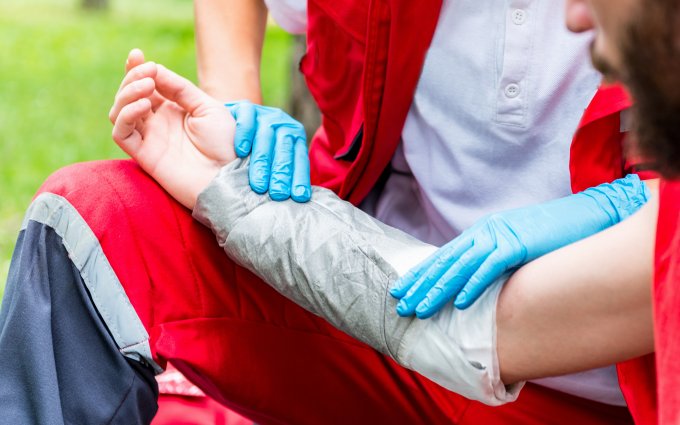12/16/2014

The 27th Annual Southern Region Burn Conference was recently hosted by John S. Dunn, Sr. Burn Center at Memorial Hermann Texas Trauma Institute in Houston, Texas. Paradigm’s Chief Medical Officer, Michael Choo, MD, attended this Southern Medical Association event and was enlightened by novel and innovative burn management approaches and therapeutics. Much of the research presented showed significant potential for improved clinical recovery and clinical outcomes from major burns. Here are three of the most exciting topics presented at the conference.
1. Heterotrophic Ossification in Burns and the Use of Botox
Heterotrophic Ossifications (HO) can occur in 13-35% of patients following major burns with total body surface area (TBSA) > 20%. HO is an abnormal formation of bone or calcification of tissue where bones normally do not exist. This is felt to occur in the body as an abnormal response to inflammation, delayed wound closure, and immobilization of greater than two months. A burn patient’s elbows are the most common areas for Heterotrophic Ossifications as compared to other conditions where shoulders, hips and knees are involved. Given the location, HO results in significantly limited range of motion and increased area nerve pain that lead to long term physical and functional difficulties.
Diagnosing HO early has always been a challenge, but early identification can be done with a three phase bone scan as early as two weeks post-injury. Current treatment involves surgical removal of the HO and rehabilitation therapy. However, an alternative approach using Botox has been shown to reduce pain, inflammation, and focal muscle dystonia/spasticity. The initial Botox study on a limited number of burn patients with TBSA > 25% with elbow HO treated with injections of Botox over the elbows resulted in a significant reduction in pain level, as well as markedly improved range of motion with improved muscle tone by 21 days post-date of injury. This avoided splinting and adaptive devices with the study subjects. In addition, the test patients ultimately attained improved ADL and experienced a higher return to work rate. Future studies are anticipated.
2. Genetically Enhanced Skin Grafts
Stratatech Corporation located in Madison, Wisconsin, has been working with the next generation of genetically enhanced skin tissue from an allogeneic keratinocyte progenitor they term “NIKS.” This cryopreserved human skin substitute tissue is truly the first universal allogeneic bi-layered human skin substitute with long shelf life to complete an FDA safety trial. Stratatech has received funding for a second clinical trial to study proof of concept in functionally and cosmetically sensitive areas involving hands, face and feet.
The platform technology permits a genetically enhanced skin substitute to be engineered with improved anti-infective, angiogenesis, and anti-proteolytic potential. This skin substitute is a fully developed and multi-layered epidermis that is remarkably strong and stable. The tissue has been shown to be just as comparable and effective in clinical outcomes compared to autograft skin grafting of burns. This product has great implications for the timing and treatment of major burn and de-gloving injuries requiring the early and extensive skin grafting necessary for burn wound coverage and recovery. The company is currently involved in the next phase of clinical trials with the NIKS tissue and hopes to aid major burn patients in the future.
3. Does Obesity Affect Outcomes of Adult Burn Patients?
Juliet Ray, MD, a Resident at the University of Miami, Miller School of Medicine posed this question in her research of the obesity factor in clinical outcomes and costs in the burn population. To conduct the research, she analyzed data from National Inpatient Sample (NIS)—the largest of all payer inpatient health care databases currently known—from the Healthcare Utilization Project (HCUP) during 2005 – 2009.
The analysis revealed obesity was associated with significantly higher rate and incidences with wound infection, urinary tract infection, and DVT & PE with TBSA > 10%. Interestingly, obesity was also associated with lower inpatient mortality/deaths. Dr. Ray hypothesized that obesity could be protective after burns due to excess energy reserve available with obesity and the higher metabolic state associated with burn patients. There was also a significant difference with obese patients being less likely to be discharged to home and experiencing higher disease severity as compared to non-obese patients. Lastly, obese patients experienced longer length of stay and higher inpatient medical costs. The study further pointed out that TBSA > 20%, obesity, older age, and black race were variables contributing to adverse events and outcomes.
This study implied the potential benefits to considering more aggressive and vigilant clinical treatment guidelines for DVT screening and prophylaxis, weight based antibiotic therapy or dosing, topical antimicrobials, and urinary catheter usage. The study’s authors are considering additional outcomes studies related to obesity
Paradigm Outcomes actively monitors and investigates cutting edge clinical therapeutics and research related to major burn conditions and medical/surgical management. Listen to a webinar replay or download a white paper for more information.